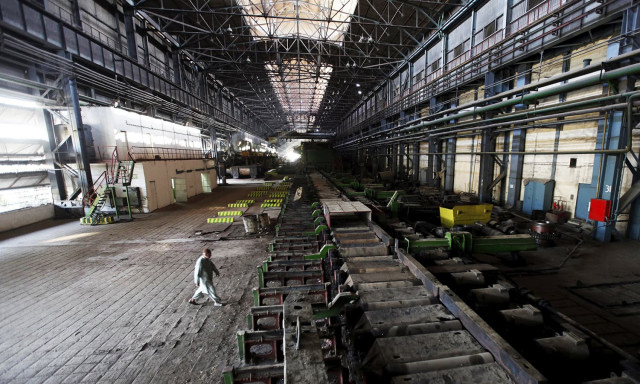PSEs and law of diminishing marginal utility
To tackle unemployment, economic expansion must outpace workforce growth

The government and the opposition are engaged in a war of words over the former’s decision to fire more than 4,500 employees of Pakistan Steel Mills (PSM), which is one of the largest public sector enterprises (PSEs) in the country.
The government has defended its decision on the ground that it was occasioned by the need to slash heavy losses in PSM as part of economic reforms, which include the restructuring of PSEs, leading possibly to their privatisation.
On the other hand, the opposition, particularly the Pakistan Peoples Party (PPP), has termed the decision an “economic murder” of PSM workers and vowed to put the retrenched employees back to work once there is change in the government.
Instead of rendering people jobless, the job of the government is to provide jobs – so goes the argument.
The government-opposition standoff over the retrenchment of PSM workers reminds us of a standard question posed in introductory textbooks of economics: “Is it possible to grow all the wheat, or for that matter any other commodity, that the world needs in a small parcel of land by supplying labour and other necessary input?”
The answer to the question, as everyone knows, is in the negative. But not everyone knows the reason for the negative answer, which rests on the law of diminishing marginal returns.
The law, which forms part of fundamentals of economics, states that if one factor of production is constantly increased while keeping others constant, it will soon result in a smaller increase in output or returns. A stage may even arise, which usually does, when the production instead of going up starts shrinking.
In our example, there is a maximum amount of wheat that can be grown in a particular parcel of land regardless of the number of farmers who plough the land from dawn to dusk. Once the maximum level of output is reached, it’s only by bringing another parcel of land under cultivation that more wheat can be produced.
The same goes for manufacturing. Hiring additional workers will add to the output of a factory. But if the management only keeps introducing more workforce without giving them more capital to work with, every additional worker will be less productive, which eventually will make the entire production process inefficient.
Not only that, while the additional workers may make at best only nominal contribution to the output, the management will have to pay them remunerations, which will add to the cost of production. Thus, the enterprise in question will be characterised by increasing costs and stagnant or shrinking output and thus falling revenue, which is a classic recipe for going bankrupt.
This is what has happened in the case of Pakistan’s PSEs including PIA and PSM, where more employee inductions relative to the level of output made them more inefficient, less productive and by implication costlier to run. Thus, once profit-making enterprises were reduced to loss-making ones and earned the sobriquet “The White Elephants.”
Job creation
The Pakistan Tehreek-e-Insaf (PTI) government has blamed its predecessors for overstaffing the PSEs and thus making them inefficient and bankrupt. But isn’t employment creation one of the prime functions of the government?
In view of enormous personal and social costs of unemployment, the answer to the question is in the affirmative. The public sector being the largest employer all over the world, including Pakistan, government departments take the lead in job creation.
Politically as well, job creation is one of the criteria by which the performance of a party in power is judged. It is therefore hard to question the employment creation role of the government.
That said, the manner in which employment opportunities are generated and people are recruited is as important as job creation itself. An ill-advised or shady way to hire people can do more harm than good.
In a mixed economy like Pakistan’s, governments generate jobs in three broad ways. One, they create jobs directly by filling positions in government, semi-government and autonomous departments or PSEs. In Pakistan, normally thousands of vacancies arise in the public sector every year and are filled.
Two, through economic policies and administrative measures, the government creates conditions which are conducive for employment creation in the private sector. An economy characterised by sound key indicators, such as a robust growth rate, is conducive for job creation.
Three, by imparting quality education and training, as well as making it mandatory for businesses to do so, the government can rack up productive capacity of the labour force and make it easier for the unemployed to find a job.
Thus, inducting people in the public sector is only one instrument of employment generation for the government. Unfortunately in Pakistan, it has been seen as the major, and in some cases, the only instrument.
Even this instrument is used in a way that has played havoc with the economy as well as the public sector and in the end resulted in more jobs being lost than created.
Cost to society, economy
Political appointments may ratchet up politicians’ popularity but they come at an enormous cost to society and the economy. If an organisation is run by incompetent persons, it will soon go off the track.
In case of a PSE, the government will have to put in heaps and heaps of money just to keep it alive. A cash-starved government like Pakistan’s will have to resort to massive borrowing at home and abroad to save its loss-making enterprises. Let there be no mistake, the cost of debt servicing is borne by the taxpayer.
Political interference also results in over-staffing of the PSEs. Surplus employees are not only a burden on finances of an organisation, they are also a drag on its output and efficiency.
Those who look at the public sector as essentially an employment bureau are holding the wrong end of the stick. In order to create jobs in the PSEs, they should first be made profitable, for it doesn’t make economic sense – though it may make a lot of political sense – to induct people in loss-making organisations.
This will entail the enterprises’ restructuring, which will shed jobs at least in the short run – a major reason every government shies away from shaking up these enterprises. The people in power, by and large, don’t like to be hemmed in by rules or prudent economic behaviour.
Unemployment can’t be eradicated just by inducting the entire jobless labour force in the public sector. If that were the case, no country would have a single unemployed person.
To overcome unemployment, economic expansion, particularly that of the labour-intensive manufacturing sector, must outpace workforce growth, otherwise the number of unemployed will continue to go up at a gallop.
Pakistan is remarkably deficient in the factors which underpin sustained economic growth and employment generation. These include human resource development, macroeconomic stability, competitiveness of the economy and of the institutions of economic governance, entrepreneurship, and business facilitation.
We are ranked 110th out of 141 nations on the Global Competitiveness Index, 108th out of 190 economies on the Ease of Doing Business Index, and 152nd out of 189 countries on the Human Development Index.
Setting our house in order in terms of such indicators has turned out to be a tall order for successive governments. But, to be sure, this is the only credible recipe for job creation.
The writer is an Islamabad-based columnist
Published in The Express Tribune, December 7th, 2020.
Like Business on Facebook, follow @TribuneBiz on Twitter to stay informed and join in the conversation.



















COMMENTS
Comments are moderated and generally will be posted if they are on-topic and not abusive.
For more information, please see our Comments FAQ